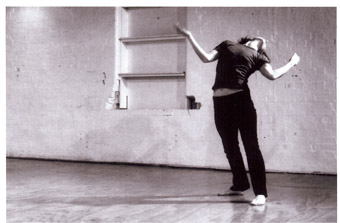nalina wait: night secrets
ashley syne

Nalina Wait
photo Andrew Whoolley
Nalina Wait
Nalina Wait is positioned in a set of perfect right angles, every hinge. Elegantly clad in soft, feminine green, her dress is modest yet exposing. Her limbs are milky soft, barely illuminated beneath a blanket of darkness. A lamp to her left leans over her. Its shade is inquisitively tilted, on the brink of toppling. The dancer’s fingers move to the lamp—it comes to life. An oscillating sound score emanates from the dark, croaking and vibrating like a mechanical insect.
The dancer’s body begins a gradual metamorphosis. The light floods, transforming Wait’s skin from a shade of pearl to warm amber. She moves through a chain reaction of twists, coils and circles which begins at her crown and end just beyond her toes. In a blend of tension and subtle calm the dancer’s tortured body is ironed into the floor. For an instant she seems to slip into an unconscious state before peeling herself from the surface. Has a slumber engulfed this helpless body or is Wait the subject of her very own lucid dream?
Suddenly on her feet, Wait moves rapidly downstage, her gaze skimming my head. Her body freezes with a numbing stare. Sporadic outbursts of flicks and flinches escape her as the ceiling lights clunk, grind and flicker on. Wait constantly arrives at a neutral stance, yet simultaneously fails to ever reach a climax in her moments of physical eruption. She is pulled through space by an external force; her limbs jolt and ripple as if wrenched from her torso in intermittent bursts. Possessed by her own nightmare, she is stolen.
In a post-performance discussion Nalina Wait says that she was influenced by the notion of “arriving and never arriving.” This is reflected through her choice of motif and in the dynamic of the work. Her body constantly struggles between stillness and spasmodic physicalisations. Much like Wait’s improvisations I’ve seen previously, the sense of presence and the movement quality of this performance are entrancing. Her dynamic shifts of weight create a mood of edginess and surprise. Much of this movement quality reflects the industrial, raw and eclectic noise of the guitar-based sound score—something new for Wait, who usually dances in silence.
Moving though a dance between her physical self, an invisible being and the floor, Wait slices the air with energetic tosses and breaks it with radical stops. What is being portrayed? Wait says that “embracing more of the psychological rather than anatomical elements” was of particular interest to her. She demonstrates this through her focus and a commitment that allows for momentum behind the movement. The choreographic detail appears to emerge more from sensation than aesthetic concerns.
Against the minimal setting of an empty room and a lamp, Wait’s movements are larger than life. Her deep lunges and abrupt foot work interweave in spirals of motion. It’s as if she’s dancing a duet with the lone lamp, detached but communicating inaudibly with it. She holds a secret she will never reveal to us. This shy object baffles me. Is it simply a lamp or is it a transportation device to take the dancer from one realm of existence into the next?
Wait’s breathing overrides the fading music, but her body resists, dancing on in silence. She gasps for air but eventually surrenders, returning to sit by the lamp. She stares, ghostly.






